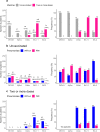Lung tropism in hospitalized patients following infection with SARS-CoV-2 variants from D614G to Omicron BA.2
- PMID: 36841870
- PMCID: PMC9959956
- DOI: 10.1038/s43856-023-00261-5
Lung tropism in hospitalized patients following infection with SARS-CoV-2 variants from D614G to Omicron BA.2
Abstract
Background: The genetic and pathogenic characteristics of SARS-CoV-2 have evolved from the original isolated strains; however, the changes in viral virulence have not been fully defined. In this study, we analyzed the association between the severity of the pathogenesis of pneumonia in humans and SARS-CoV-2 variants that have been prevalent to date.
Methods: We examined changes in the variants and tropism of SARS-CoV-2. A total of 514 patients admitted between February 2020 and August 2022 were included and evaluated for pneumonia by computed tomography (CT) as a surrogate of viral tropism.
Results: The prevalence of pneumonia for each variant was as follows: D614G (57%, 65/114), Alpha (67%, 41/61), Delta (49%, 41/84), Omicron BA.1.1 (26%, 43/163), and Omicron BA.2 (11%, 10/92). The pneumonia prevalence in unvaccinated patients progressively declined from 70% to 11% as the variants changed: D614G (56%, 61/108), Alpha (70%, 26/37), Delta (60%, 38/63), BA.1.1 (52%, 15/29), and BA.2 (11%, 2/19). The presence of pneumonia in vaccinated patients was as follows: Delta (16%, 3/19), BA.1.1 (21%, 27/129), and BA.2 (11%, 8/73). Compared with D614G, the areas of lung involvement were also significantly reduced in BA.1.1 and BA.2 variants.
Conclusions: Compared with previous variants, there was a marked decrease in pneumonia prevalence and lung involvement in patients infected with Omicron owing to decreased tropism in the lungs that hindered viral proliferation in the alveolar epithelial tissue. Nevertheless, older, high-risk patients with comorbidities who are infected with an Omicron variant can still develop pneumonia and require early treatment.
Plain language summary
The SARS-CoV-2 virus changes over time with the differing viruses described as variants. The different variants of SARS-CoV-2 have an impact on how easily they infect people and the effects they have on infected individuals. Here, we examined images of the lungs of patients hospitalized with COVID-19 to investigate whether they had pneumonia, a type of swelling in the lung. Compared with the variant found early in the pandemic, the more recent Omicron variant led to a decreased rate of pneumonia in infected individuals. Our findings emphasize the need for early treatment, as pneumonia may progress in older patients or those with other illnesses.
© 2023. The Author(s).
Conflict of interest statement
The authors declare no competing interests.
Figures





Similar articles
-
The Omicron Variant BA.1.1 Presents a Lower Pathogenicity than B.1 D614G and Delta Variants in a Feline Model of SARS-CoV-2 Infection.J Virol. 2022 Sep 14;96(17):e0096122. doi: 10.1128/jvi.00961-22. Epub 2022 Aug 24. J Virol. 2022. PMID: 36000850 Free PMC article.
-
The Omicron variant BA.1.1 presents a lower pathogenicity than B.1 D614G and Delta variants in a feline model of SARS-CoV-2 infection.bioRxiv [Preprint]. 2022 Jun 16:2022.06.15.496220. doi: 10.1101/2022.06.15.496220. bioRxiv. 2022. Update in: J Virol. 2022 Sep 14;96(17):e0096122. doi: 10.1128/jvi.00961-22. PMID: 35734088 Free PMC article. Updated. Preprint.
-
The SARS-CoV-2 Spike is a virulence determinant and plays a major role on the attenuated phenotype of Omicron virus in a feline model of infection.J Virol. 2024 Mar 19;98(3):e0190223. doi: 10.1128/jvi.01902-23. Epub 2024 Feb 29. J Virol. 2024. PMID: 38421180 Free PMC article.
-
Comparison of Neutralizing Activity between Vaccinated and Unvaccinated Hospitalized COVID-19 Patients Infected with Delta, Omicron BA.1, or Omicron BA.2 Variant.Microorganisms. 2024 Mar 2;12(3):509. doi: 10.3390/microorganisms12030509. Microorganisms. 2024. PMID: 38543560 Free PMC article.
-
Emergence of SARS-CoV-2 Variants in the World: How Could This Happen?Life (Basel). 2022 Jan 28;12(2):194. doi: 10.3390/life12020194. Life (Basel). 2022. PMID: 35207482 Free PMC article. Review.
Cited by
-
4D-DIA Proteomics Uncovers New Insights into Host Salivary Response Following SARS-CoV-2 Omicron Infection.J Proteome Res. 2025 Feb 7;24(2):499-514. doi: 10.1021/acs.jproteome.4c00630. Epub 2025 Jan 13. J Proteome Res. 2025. PMID: 39803891 Free PMC article.
-
Dynamic Interaction Between SARS-CoV-2 and Influenza A Virus Infection in Human Respiratory Tissues and Cells.Microorganisms. 2025 Apr 25;13(5):988. doi: 10.3390/microorganisms13050988. Microorganisms. 2025. PMID: 40431161 Free PMC article.
-
COVID-19 Vaccine Boosters in People With Multiple Sclerosis: Improved SARS-CoV-2 Cross-Variant Antibody Response and Prediction of Protection.Neurol Neuroimmunol Neuroinflamm. 2025 Sep;12(5):e200443. doi: 10.1212/NXI.0000000000200443. Epub 2025 Jul 22. Neurol Neuroimmunol Neuroinflamm. 2025. PMID: 40694731 Free PMC article.
-
Effectiveness of the severe acute respiratory syndrome coronavirus 2 Omicron BA.5 bivalent vaccine on symptoms in healthcare workers with BA.5 infection.Vaccine X. 2024 Jan 6;17:100433. doi: 10.1016/j.jvacx.2024.100433. eCollection 2024 Mar. Vaccine X. 2024. PMID: 38299200 Free PMC article.
-
A Pictorial Essay Describing the CT Imaging Features of COVID-19 Cases throughout the Pandemic with a Special Focus on Lung Manifestations and Extrapulmonary Vascular Abdominal Complications.Biomedicines. 2023 Jul 26;11(8):2113. doi: 10.3390/biomedicines11082113. Biomedicines. 2023. PMID: 37626610 Free PMC article. Review.
References
Grants and funding
LinkOut - more resources
Full Text Sources
Miscellaneous

